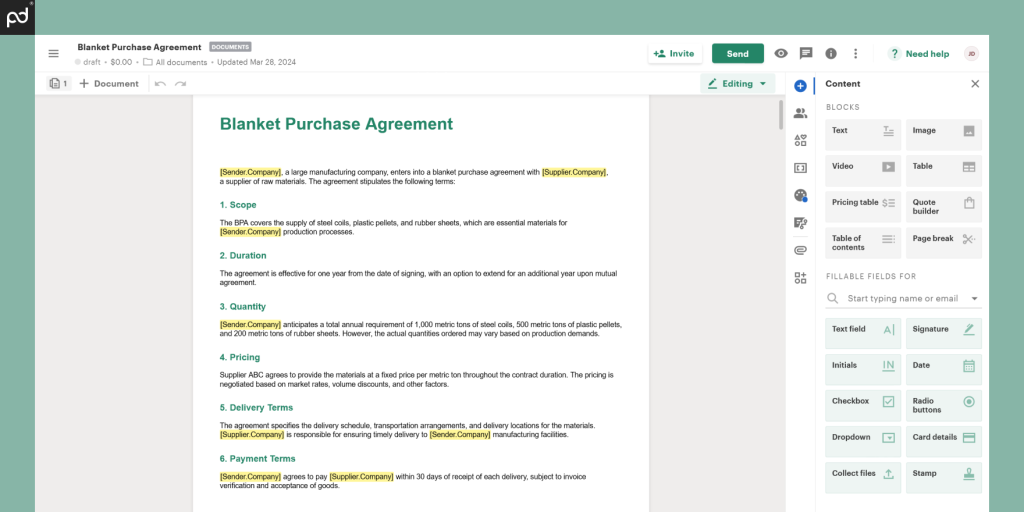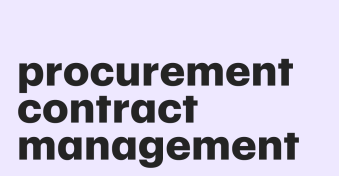If your organization makes repeated orders or purchases of the same products or services, using a blanket purchase agreement (BPA) can be a great way to complete these orders automatically.
By specifying key details such as invoicing or delivery information ahead of time, using a BPA allows you to speed up the ordering and purchasing process.
Read our ultimate guide to learn more about BPAs and how to use them in your organization.
Key takeaways
- BPAs make repetitive purchases within one single agreement.
- Blanket purchase agreements are often popular with government agencies.
- BPAs can improve cost savings as well as increase time efficiency.
- You should avoid using BPAs when you expect costs to decrease.
What is a blanket purchase agreement (BPA)?
A blanket purchase agreement (BPA) — also known as a blanket purchase order (BPO) — is essentially an extension of any contract you make with a supplier when you make a purchase.
Rather than only dealing with the current purchase, a BPA is a long-term contract that can be extended over time.
By using a long-term approach, the BPA will allow the supplier to provide you with the product repeatedly.
These repeated purchases will be at one set price, saving you negotiation time.
BPAs also come with a set time period.
This means that you need to agree on a timeframe and a set price with your supplier ahead of time, which is a great way to deal with planning shipments and deliveries and reduce the problems caused by price fluctuation.
Common applications
BPAs are used across a wide range of businesses and organizations.
After all, even the smallest businesses will know how annoying it can be to repetitively make the same orders every week.
However, BPAs are commonly applied in government contracts and procurement.
That’s because of the requirement to work within a strict budget planned ahead of time.
You’ll often find BPAs used for purchases in areas as diverse as providing office supplies, delivering maintenance or repair operations, and supplying software agreements.
That’s because they can be applied to any purchases that take place repeatedly over an extended period of time.
Restrictions
Of course, there are some restrictions that you should keep in mind before using a BPA.
They should be restricted when the pricing may be lower in the future, as you’re potentially tying yourself to a needlessly expensive contract by using a BPA.
As well as this, you should only use a BPA when you have a significant amount of trust in the supplier.
An unreliable vendor who struggles to meet delivery deadlines is not a good partner to work with through a long-term purchase contract.
What is the main difference between blanket purchase agreements and basic agreements?
Probably the biggest difference between BPAs and basic agreements is that BPAs are for multiple orders, while basic agreements typically only cover a single purchase.
Because of this, a BPA will usually have a set start and end date.
Another key difference is in the level of detail in each agreement.
When planning for multiple deliveries in a BPA, you need to leave room for adaptation so you shouldn’t use too much detail.
On the other hand, a basic agreement that focuses on one purchase should be as specific as possible.
Different types of blanket purchase agreements
As we’ve already highlighted, BPAs can be applied in various contexts.
Because of that, there are also various types of BPAs. Here are two of the most widely used BPAs:
Standing orders
This is the fundamental version of a BPA.
By giving a set time period in which deliverables are provided — as well as the means and terms of payment — standing orders are a straightforward way to bring in required goods or services repeatedly and reliably.
Planned purchase orders
These are very similar to standing orders. However, planned purchase orders don’t include a clear delivery schedule.
This means a planned purchase order can simply be used whenever you need to bring in the goods.
All you need to do is request the delivery, giving you more freedom than using a standing order.
When to use a BPA
If you’re thinking about whether it’s the right time to use a BPA, here are the main things to consider:
- Vendor trust: It’s crucial that you have a strong relationship with the seller and that you can trust them to complete deliveries over a long time period.
- Bulk discounts: If your seller offers bulk discounts, it might be the right time to take advantage of them by using a BPA.
- Projected needs: You always need to have a clear image of your projected needs over the medium and long term before you use a BPA. You don’t want to get locked into a contract that becomes redundant if your needs change.
How do government agencies establish a BPA?
As we’ve already said, government agencies commonly use BPAs to complete their procurement as efficiently as possible.
You need to create a bidding process to set up a BPA as a government agency.
This is so that the price is “fair and competitive,” ensuring that the taxpayer gets good value for money.
What to include on a blanket purchase agreement
When you’re compiling a BPA, it’s important that you include all of the following features of a blanket purchase agreement:
- Contract period: As a BPA is used to purchase goods or services over the long-term, it’s vital that you clearly state the contract period. Make sure that both parties know when the contract lasts to — and also include a mechanism for extending the contract.
- Product quantity: You need to make sure that the quantity of the product is included. You might also want to specify the quality that you expect.
- Fixed price: One of the best parts of using a BPA is that it provides a fixed price for goods, so remember to include the set price in your agreement.
- Payment and delivery terms: The practical details are as invaluable in a BPA as in any other valid contract.
- Invoicing details: Blanket purchase agreements must be treated similarly to invoices or other legal contracts. You should include features such as a unique reference number or some other means to assist your accounting teams.

How long can a blanket purchase agreement last?
Blanket purchase agreements can last as long as you like. However, it’s recommended that they don’t go on for longer than five years.
This protects you against getting stuck in a contract that is unsuitable or poor value for money.
What are the advantages and disadvantages of a blanket purchase agreement?
| Advantages | Disadvantages |
|---|---|
| Efficiency: By making just one purchase for multiple deliverables, you make the whole process of procurement much more time-efficient. | Accuracy: When planning orders months or years in advance, it can be difficult to accurately predict how many purchases you need to make. |
| Cost savings: As well as being time efficient, you’ll also see that using a BPA will bring significant cost savings to your organization. You can often receive discounts by buying in bulk through a BPA. | Monitoring compliance: When you don’t receive a single-purchase order, it’s difficult to miss it. However, one missed shipment on a BPA can often go under the radar. That’s why it’s vital that you choose a vendor that you trust. |
| Avoiding price fluctuations: The set prices built into a BPA are a great way to plan for your organization’s financial future. This is because the set prices will remain the same, regardless of any wider price fluctuations, allowing you to budget years in advance. | Not benefitting from falling prices: Although price fluctuations can make budgeting difficult, if those prices are falling, using a BPA can mean that you’re spending more on your purchases than would otherwise be necessary. |
Blanket purchase agreement example
Company XYZ, a large manufacturing company, enters into a blanket purchase agreement with Supplier ABC, a supplier of raw materials.
The agreement stipulates the following terms:
Scope
he BPA covers the supply of steel coils, plastic pellets, and rubber sheets, which are essential materials for Company XYZ’s production processes.
Duration
The agreement is effective for one year from the date of signing, with an option to extend for an additional year upon mutual agreement.
Quantity
Company XYZ anticipates a total annual requirement of 1,000 metric tons of steel coils, 500 metric tons of plastic pellets, and 200 metric tons of rubber sheets.
However, the actual quantities ordered may vary based on production demands.
Pricing
Supplier ABC agrees to provide the materials at a fixed price per metric ton throughout the contract duration.
The pricing is negotiated based on market rates, volume discounts, and other factors.
Delivery terms
The agreement specifies the delivery schedule, transportation arrangements, and delivery locations for the materials.
Supplier ABC is responsible for ensuring timely delivery to Company XYZ’s manufacturing facilities.
Payment terms
Company XYZ agrees to pay Supplier ABC within 30 days of receipt of each delivery, subject to invoice verification and acceptance of goods.
Quality assurance
Supplier ABC is required to adhere to quality standards and specifications specified by Company XYZ.
The agreement includes provisions for quality inspections, rejection of non-conforming goods, and remedies for defective products.
Termination clause
Both parties have the right to terminate the agreement with prior written notice if certain conditions are met, such as material breach, insolvency, or unforeseeable circumstances or events.
Throughout the contract period, Company XYZ can issue individual purchase orders against the BPA as needed to procure the specified materials from Supplier ABC.
The BPA streamlines the procurement process, provides cost savings through volume discounts, and ensures a reliable supply of materials to support Company XYZ’s production operations.
It can often be challenging to build contracts such as a BPA from scratch, so blanket purchase agreement templates are useful.
If you’re looking for an example of this, take a look at PandaDoc’s purchase order template.
By using these types of templates, you’ll be able to adapt them to your specific organizational context, whether in government procurement or simply making your business more efficient.
Create your perfect business document and save time with PandaDoc’s template library
There’s no doubt that using blanket purchase agreements is a brilliant way to cut costs, improve efficiency, and avoid price fluctuations.
By simply ordering your supplies in advance, you can make your organization run much more smoothly.
That’s why blanket purchase orders (BPAs) are becoming increasingly popular.
If you want to continue saving time — including by using a BPA template — PandaDoc’s template library is a great way to make your document workflow more streamlined and efficient. Start using BPA template examples today!
Disclaimer
PandaDoc is not a law firm, or a substitute for an attorney or law firm. This page is not intended to and does not provide legal advice. Should you have legal questions on the validity of e-signatures or digital signatures and the enforceability thereof, please consult with an attorney or law firm. Use of PandaDoc services are governed by our Terms of Use and Privacy Policy.
Frequently asked questions
-
BPAs and IDIQs are very similar. However, IDIQs are used when the buyer doesn’t yet know the exact quantities of their deliverables.
-
GSA schedules are used in government procurement specifically, as they indicate that the suppliers have been vetted by the government. BPAs, however, can be used by any business.
-
The ideal BPA suppliers will depend on your organization—you need to make sure that you can trust them and that you have an existing relationship with them.


